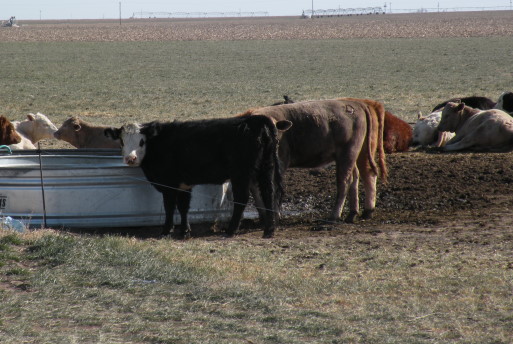
Agricultural News
Dr. Norm Stewart of Intervet/Schering Plough Animal Health Talks Pinkeye Control
Thu, 25 Feb 2010 13:07:52 CST

As pinkeye season approaches, it's time for beef producers to take preventive steps to control this contagious, costly disease. Pinkeye losses can exceed $100 per incidence in beef cattle. Norm Stewart, D.V.M., M.S., Manager of Technical Services for Intervet/Schering-Plough Animal Health, offers best management practices for preventing pinkeye.
"Taking a stand against pinkeye requires a three-pronged approach that includes vaccination, fly control and environmental management," Stewart says, "Like a three-legged stool, leaving out any of these key elements can bring down your entire control program."
Protect the eyes
Stewart says the first leg of control is vaccination. "Pinkeye is caused when bacterial organisms such as Moraxella bovis infect the surface of the eye," explains Stewart.
Pinkeye vaccines stimulate the production of antibodies in tears that bathe the eye, limit infection and reduce the severity of lesions. To allow adequate development of immunity, he advises vaccinating animals three to six weeks prior to the onset of pinkeye season.
There are many different strains of Moraxella bovis, in addition to evolving bacteria, which can cause pinkeye," explains Stewart. "Work with your veterinarian or animal health provider to identify a broad-spectrum vaccine effective against a wide variety of common infectious strains and isolates."
Stop the flies
The second key to preventing pinkeye is fly control, Stewart says, because pinkeye can spread rapidly from flies that transport bacteria from the eyes of one animal to another. Face flies can travel significant distances between herds and can expose animals to different strains of Moraxella bovis.
"This is why vaccination with a broad-spectrum pinkeye vaccine and fly control are such critical legs of the pinkeye prevention stool," Stewart explains.
Effective fly control requires customization to your production system. Stewart suggests the following best management practices to reduce the impact flies have on the spread of pinkeye:
Treat animals of all ages and their premises with an effective, long-lasting and easy to administer insecticide
For calves and cows, apply two ear tags per animal, in addition to a low-volume, long-lasting pour-on for rapid knockdown of the existing fly population. Reapply the pour-on as needed
For premise control, use an insecticide such as a microencapsulated product that delivers superior, long-lasting control on a wide variety of surfaces in and around livestock facilities
Use additional fly-control measures as necessary, such as back-rubbers, oilers and other devices that can be used on pasture
When ear tags lose their effectiveness, remove them and apply a final dose of a low-volume pour-on
If you believe a product is not working, contact the manufacturer and your animal health provider to discuss the situation and get help
Reapply insecticides throughout the fly season, and always follow label directions.
Manage the environment
The environment is the third area of focus in preventing pinkeye, Stewart says. Management practices such as pasture mowing, dust control and man-made or natural shades are important to minimize eye irritants, such as pollen, seed heads, dust and ultraviolet light.
These environmental factors cause irritation and physical damage, allowing infectious pinkeye organisms to attach to the surface of the eye. These irritants can also cause the eye to tear. Tearing, watery eyes can attract flies, which feed on the watery secretions from the eye and surrounding tissue. Since face flies travel from animal to animal, they can rapidly spread Moraxella bovis throughout the herd, dramatically increasing the incidence of pinkeye in a short amount of time.
"Ultimately, controlling pinkeye requires a planned attack. And like a three-legged stool, pinkeye control requires three important elements to work well vaccination, fly control and environmental management," says Stewart.
WebReadyTM Powered by WireReady® NSI
Top Agricultural News
More Headlines...




















